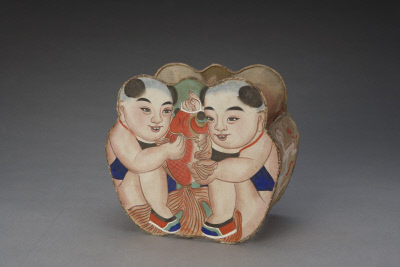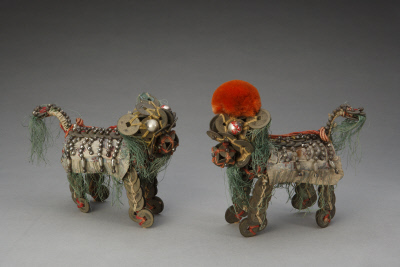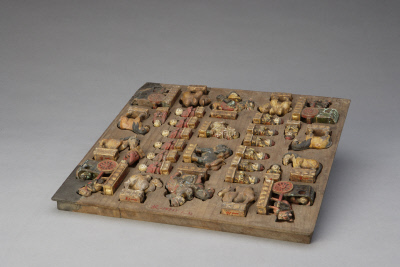RESOURCES
2016-06-01 Source: China Daily
International Children's Day is coming up on Wednesday. Parents have selected many kinds of toys as gift, varying from dolls to bricks. There seem to be too many choices.
But can you imagine what toys children in the Forbidden City played with one century ago?
In the Qing court, a number of toys were prepared by the empress and imperial concubines during festivals for the little princes and princesses. During the late Qing Dynasty, there was a spike in the number of toys given, because Emperor Tongzhi was only 6 years old and Emperor Guangxu was 4 years old when they were enthroned. The last emperor of the dynasty, Pu Yi, was pushed to the throne at the age of 3. Being the ruler of the country, he was no more than a child. So toys were used to entertain the little emperor.
From traditional folk toys like clay figurines and cloth tigers, to imported western devices such as music boxes and building blocks, there was a wide range of toys in the Forbidden City. These toys fully reflect the integration of folk style, royal style and exotic style, which also reflect late Qing society during the period of the Republic of China.

The children holding a goldfish lantern, kept at the Palace Museum. [Photo/dpm.org.cn]
Lanterns
This lantern is framed by wire and pasted with painted gauze. On both sides, it is painted with the design of two boys holding a goldfish. On the flanks are bat patterns on the auspicious implies. This lantern was made according to the customs of admiring festive lanterns during the Lantern Festival, which falls on the 15th day of the first lunar month.

A cloth tiger kept at the Palace Museum. [Photo/dpm.org.cn]
Cloth tiger
The big-headed and long-tailed cloth tiger is painted with tabby decoration, with a pattern of “王” (the character means king) at the top of its head, looks charmingly naive. There were once inlaid with glass eyeballs, which now are lost. This cloth tiger can be used as a toy during the daytime and as a pillow during the night. It is cute as well as functional.
The cloth tiger is deemed to be a symbol of exorcism, disaster prevention, peace and good luck, and it can also protect one’s fortune. During the Dragon Boat Festival on the fifth day of the fifth lunar month, it is very popular to make the cloth tiger for children, according to the characteristics of the tiger, symbolizing health, strength and boldness.

A pair of lions plaited with copper coins, kept at the Palace Museum. [Photo/dpm.org.cn]
Copper coins plaited lions
This pair of lions is plaited with copper coins and is decorated with metallic beads. The male is wearing a red ball of fluff. These lions are skillfully constructed in a unique way. They once were exhibited at a 1924 charity exhibition held in Xi’an, making them remarkable and of special contribution among toys from the Qing court.

Celluloid Chinese tumblers kept at the Palace Museum. [Photo/dpm.org.cn]
Celluloid Chinese tumblers
The Chinese tumbler, a toy that wobbles but quickly rights itself, has been popular in China for centuries. The tumbler was developed from a kind of drinking vessel used during the Tang Dynasty (618 - 907). Traditional Chinese tumblers are made of natural materials, such as clay and paper, but these Qing tumblers are made of celluloid, showing the characteristics of the time.

Silver ships kept at the Palace Museum. [Photo/dpm.org.cn]
Silver ships
The bigger ship in the middle is of traditional style and decorated with qilin (Chinese unicorns) and flowing cloud patterns. There are wheels on the bottom, and a spring at the stern. After winding up, the ship can move across a flat surface.

Silver ships kept at the Palace Museum. [Photo/dpm.org.cn]
Music box
The gilded square singing bird music box was produced in France. The gilt copper birdcage sits on a wooden base that is carved with floral designs. A couple of little birds with bright-colored feathers are standing on a tree branch in full bloom in a landscape.
It is a technological marvel, with extremely intricate internal movements that produce the incredibly realistic sound of real singing birds, combined with the chirping and fluttering movements of a life-like mechanical bird clad in real feathers. On sliding the operating lever, the full-bodied birds begin singing, butterflies flap their wings as if to fly and the stream babbles among rocks.

A wooden melodica kept at the Palace Museum. [Photo/dpm.org.cn]
Wooden melodica
The melodica is a free-reed instrument similar to the melodeon and the harmonica. It has a musical keyboard on top and is played by blowing air through a mouthpiece that fits into a hole in the side of the instrument. Pressing a key opens a hole, allowing air to flow through a reed. Melodicas are small, light, portable, and easy to learn, making it a popular toy in the Forbidden City.

The Mongolian chess kept at the Palace Museum. [Photo/dpm.org.cn]
Mongolian chess
Mongolian chess, also called shatar, probably first appeared when Genghis Khan went on his western expedition during the 13th century. It was then introduced to the center of China during the early Qing Dynasty.
Mongolian chess is quite similar to Chinese chess, but the form, rules and ways to move the chess pieces are more like international chess. There are 32 pieces total. The piece that corresponds to the king is depicted by a cavalier riding on a horse. The piece corresponding to the western bishop is a two-humped camel. The piece corresponding to the knight is, not surprisingly, a standing horse. Rooks are represented by horse-drawn carts. The pawn is smaller than the other pieces and it can look like a small sitting person.